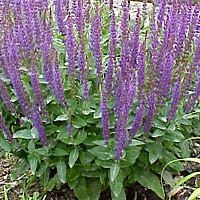Salvia

Salvias are a large group of garden plants that includes annuals, biennials, perennials, and shrubs. The perennial salvias are mainstays of the midsummer garden border. Another common name is sage.
About This Plant
A relative of the familiar kitchen sage, flowering salvias produce spikes of small, densely packed flowers atop aromatic foliage. These heat- and drought-tolerant beauties bloom from early to late summer in shades of blue, violet, red, pink, and white. Plants grow 18 inches to 5 feet tall, depending on the variety. Use care when choosing salvias, because not all plants are hardy in all regions.
Special Features
Easy care/low maintenance
Good for cut flowers
Attracts hummingbirds
Tolerates dry soil
Site Selection
Select a site with full sun and very well-drained soil.
Planting Instructions
Plant in spring, spacing plants 1 to 3 feet apart, depending on the variety. Prepare the garden bed by using a garden fork or tiller to loosen the soil to a depth of 12 to 15 inches, then mix in a 2- to 4-inch layer of compost. Dig a hole twice the diameter of the pot the plant is in. Carefully remove the plant from its container and place it in the hole so the top of the root ball is level with the soil surface. Carefully fill in around the root ball and firm the soil gently. Water thoroughly.
Care
Apply a thin layer of compost each spring, followed by a 2-inch layer of mulch to retain moisture and control weeds. Water plants during the summer if rainfall is less than 1 inch per week. Some types can be sheared back after flowering to induce a second flush of flowers in fall. After the first killing frost, cut stems back to an inch or two above soil line. Divide plants every 3 to 4 years as new growth begins in the spring, lifting plants and dividing them into clumps.






 Salvias are a large group of garden plants that includes annuals, biennials, perennials, and shrubs. The perennial salvias are mainstays of the midsummer garden border. Another common name is sage.
Salvias are a large group of garden plants that includes annuals, biennials, perennials, and shrubs. The perennial salvias are mainstays of the midsummer garden border. Another common name is sage.